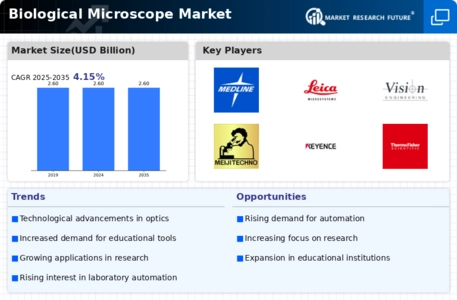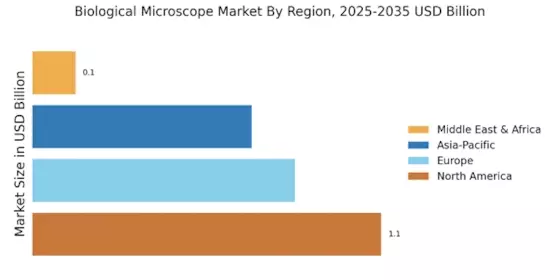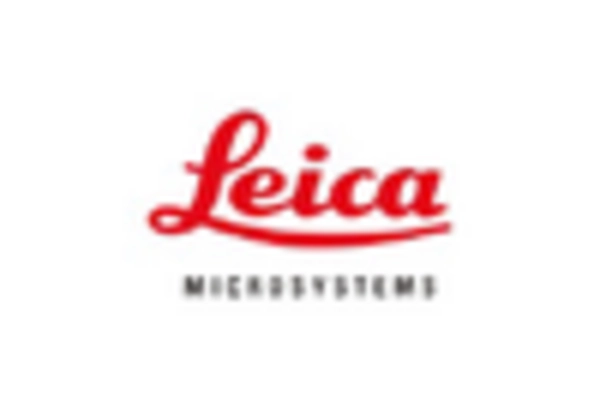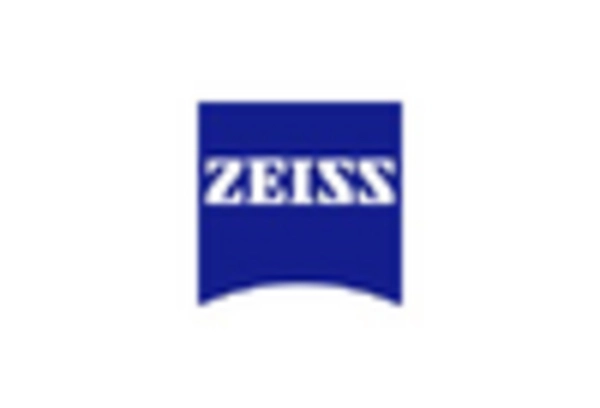Educational Sector Growth
The Biological Microscope Market is significantly influenced by the growth of the educational sector, particularly in life sciences and related fields. Educational institutions are increasingly incorporating advanced microscopy into their curricula to provide students with hands-on experience in biological research. This trend is evident in the rising number of biology and life sciences programs that emphasize practical training using biological microscopes. As educational budgets expand, institutions are investing in modern microscopy equipment, which is expected to drive market growth. The educational segment is projected to contribute notably to the overall market, as more students are trained in microscopy techniques, fostering a new generation of researchers.
Increased Adoption in Healthcare
The Biological Microscope Market is witnessing heightened adoption within the healthcare sector, particularly in pathology and diagnostics. As healthcare providers strive for accurate and timely diagnoses, the demand for high-quality biological microscopes is on the rise. The integration of digital imaging technologies into traditional microscopy is enhancing diagnostic capabilities, allowing for better visualization of tissue samples. According to recent data, the healthcare segment is expected to account for a substantial share of the market, driven by the increasing prevalence of chronic diseases and the need for advanced diagnostic tools. This trend underscores the critical role that biological microscopes play in modern medical practices.
Expanding Applications in Biotechnology
The Biological Microscope Market is benefiting from the expanding applications of microscopy in biotechnology. As biotechnological research progresses, the need for precise imaging techniques to study cellular structures and functions becomes paramount. Biological microscopes are essential tools in various biotechnological applications, including drug development, genetic research, and agricultural biotechnology. The market is likely to see a significant increase in demand from biotechnology firms, which are increasingly relying on advanced microscopy to drive innovation. This trend is supported by the growing investment in biotechnology research, which is projected to reach billions in the coming years, further propelling the biological microscope market.
Technological Integration and Innovation
The Biological Microscope Market is characterized by ongoing technological integration and innovation, which is reshaping the landscape of microscopy. The advent of digital microscopy, automated imaging systems, and artificial intelligence is revolutionizing how biological samples are analyzed. These advancements not only enhance the efficiency of microscopy but also improve the accuracy of results. The market is likely to see a proliferation of smart microscopes equipped with advanced software capabilities, enabling researchers to conduct complex analyses with ease. This trend is indicative of a broader movement towards automation and digitalization in scientific research, which is expected to drive substantial growth in the biological microscope market.
Rising Research and Development Activities
The Biological Microscope Market is experiencing a surge in research and development activities, driven by the increasing need for advanced imaging techniques in various scientific fields. Institutions and laboratories are investing significantly in R&D to enhance the capabilities of biological microscopes, leading to innovations such as improved resolution and enhanced imaging modalities. This trend is reflected in the growing number of patents filed in microscopy technologies, indicating a robust pipeline of new products. Furthermore, the market is projected to witness a compound annual growth rate of approximately 6% over the next five years, as researchers seek more sophisticated tools to explore biological phenomena at the cellular and molecular levels.


















Leave a Comment